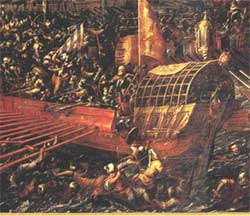Battle Of Lepanto
The Battle of Lepanto was fought on 7 October 1571 when the fleet of the Holy League, a coalition of Spain, the Republic of Venice, the Papacy, the Republic of Genoa, the Duchy of Savoy, and the Knights of Malta, obtained a decisive victory against the Ottoman fleet. For such a hugely important battle with so much at stake, the engagement at Lepanto was incredibly short: it lasted only five hours.

Andrea Vicentino
Battle of Lepanto
Palazzo Ducale, Venice
Forces engaged in the Battle of Lepanto
The allied armada had around 200 ships. Of these full two-thirds were "royal galleys." Venice alone contributed one hundred and six, besides six galeazzas, ships of enormous bulk, carrying each more than forty pieces of artillery.
The art was present even in war. One could tell that the battle took place during the Renaissance, as many of these vessels, especially the galleys, were richly carved and gilt. None exceeded the Real, the galley of Don Juan de Austria, the commander-in-chief of the allied force.
Besides approximately thirteen thousand sailors manning the ships, the number of soldiers amounted to twenty-nine thousand, including more than ten thousand experienced veterans from Spain, seven thousand Germans, and thirteen thousand Italians, of which six thousand were Venetians.
The Turkish fleet consisted of nearly two hundred and fifty galleys, most of them of the largest class. The men on board numbered around thirteen thousand sailors, and thirty four thousand soldiers.
The lines of battle
The Battle of Lepanto was fought mainly between rowing ships, so, from Messina, it took Don Juan four days to reach the Gulf of Lepanto. On the 7th of October, the watchman on the Real announced that the whole Ottoman fleet was in sight. Word was sent immediately to Andrea Doria, who commanded on the right. Don Juan unfurled the great standard of the League, given by the Pope St. Pius V, and ordered a gun to fire, giving the signal for battle.
When the battle began, the allied armada extended on a front of three miles. Far on the right, sixty-four galleys were commanded by the Genoese admiral, Andrea Doria.The centre, or battle, consisting of sixty-three galleys, was led by Don Juan himself, supported on one side by Colonna, the captain-general of the Pope, and on the other by the Venetians under Veniero. Immediately in the rear was the galley of the Grand Commander Requesens. The left wing was commanded by a Venetian, Barbarigo, and the reserve, consisting of thirty-five galleys, was given to Alvaro de Bazan, Marquis de Santa Cruz.
A novelty for a naval battle of the time was the presence of the heavily armed Venetian galeazzas which were towed half a mile ahead of the fleet.
The Ottoman fleet spread out its galleys in the form of a regular half moon. The centre was commanded by Ali Pasha, the right wing by Mehmet Pasha (or Mahomet Sirocco), and the left was under the command of Uluch Ali.
The Battle of Lepanto, the greatest naval battle of the Renaissance, has a huge significance as it stopped the Turkish advance in the Mediterranean, and also shattered the myth of Ottoman invincibility.
How the battle was fought: